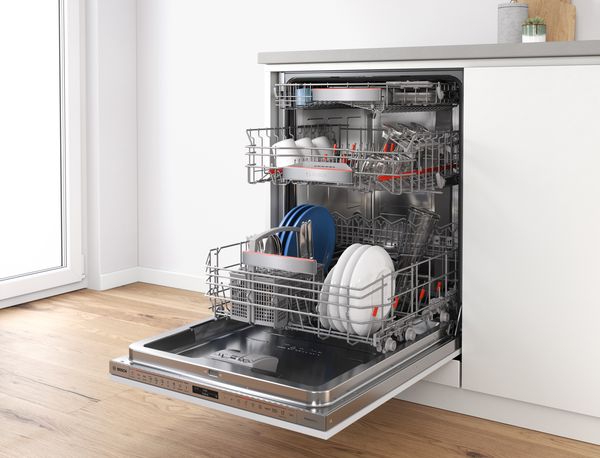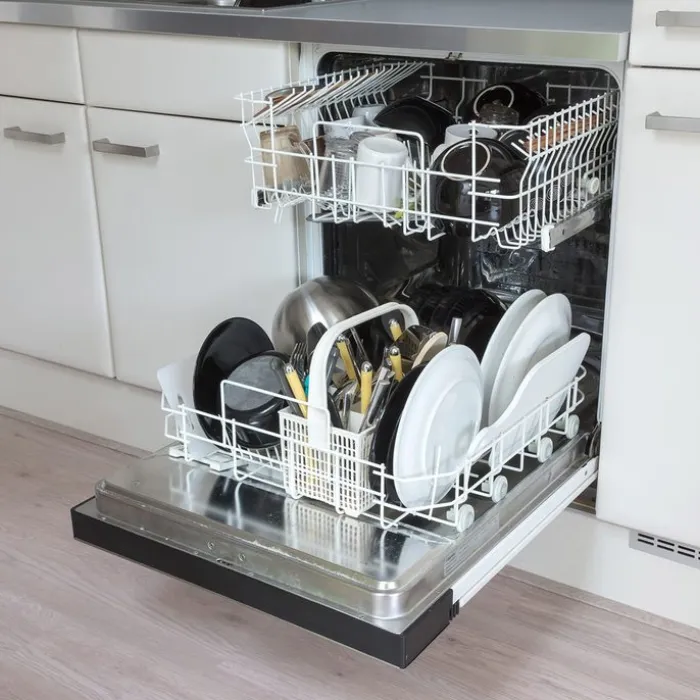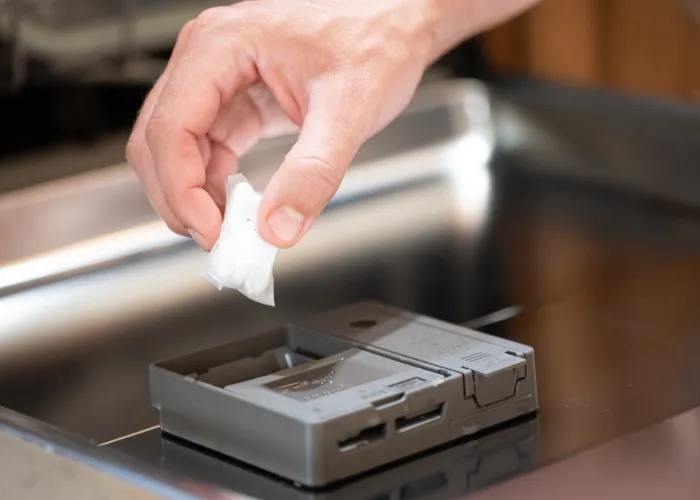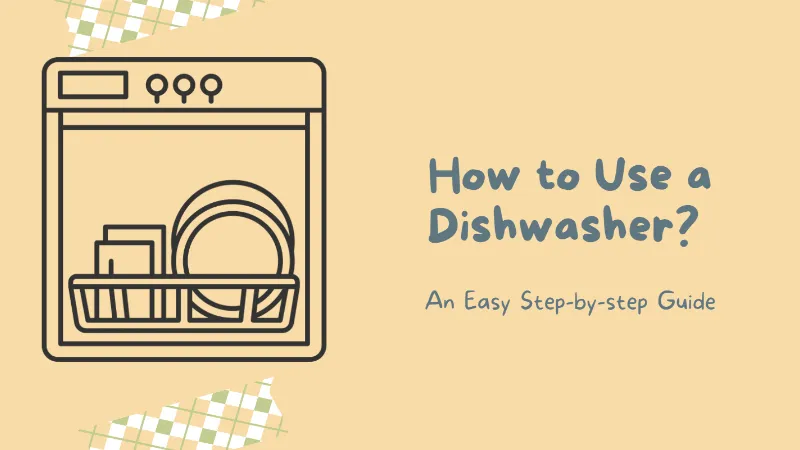When it comes to cleaning dishes and cookware with a fraction of the effort of hand washing, dishwashers are invaluable. Here’s how to use a dishwasher:
- Load the dishwasher, taking care that the swivel arm is unimpeded and items are properly placed on shelves.
- Place dishwasher tablet in bracket and close baffle. If you do not use 3-in-1 tablets, make sure that the machine has the rinsing agent and salt.
- Turn on the dishwasher using the power button on the control panel.
- Select a wash program.
- If necessary, use a delay timer to set a delay start.
- Close the dishwasher door and the machine will start automatically.
You can use this manual to learn how to load a dishwasher correctly, how to run it, which cycle to use for best results, how to pick the right detergent, and how to load it into the dishwasher.
How to Load a Dishwasher?
How well you load your dishwasher before you even press the start button has a significant impact on how well it will wash, regardless of whether you want to run a light wash or clean up all the buildup on your cookware after a significant baking session. To achieve the best results, look for a dishwasher with flexible features, such as foldable tines on the bottom rack to accommodate pots and pans, movable cutlery baskets to accommodate all of your plates in the configuration you want, and rack options in the upper basket for your smaller utensils and items like espresso cups.

Load the Dishwasher Detergent
While it may vary depending on the model, most detergent dispensers are located on the inside bottom portion of the dishwasher door. To load detergent into the dishwasher correctly:
Put detergent in the dispenser for laundry detergent.
Add rinse aid to the rinse aid dispenser up to the line that says (Available on some models) Full. If your dishwasher lacks a dedicated rinse aid dispenser, you can buy a rinse aid basket or use rinse aid-infused detergent tablets or packs.
Close the lid and firmly press down until it clicks shut. The lid of the dishwasher opens to mix the detergent and water after the initial pre-wash cycle is finished.
The effectiveness of your dishwasher depends on the detergent you use. Only use detergent that’s specifically formulated for automatic dishwashers, and don’t use dish soap in the dishwasher, even in a pinch. There are many different detergents available, including liquid, powder, gels, tablets, and packs. Although tablets and packs eliminate the need for guesswork when determining how much detergent to use, the choice of detergent to use ultimately comes down to personal preference. Fill the dispenser to the fill line, which is present on the majority of models, if you’re using liquids, powders, or gels.
How to Use Dishwasher Tablets?
Using regular dishwashing liquid, such as what you use to hand wash your dishes, will produce a lot of suds and may damage the dishwasher, so when it comes to washing your dishes in a dishwasher, you must use detergent that has been specially formulated for use in dishwashers. Powder, liquid/gel, or tablet detergents are all suitable substitutes for traditional detergents in a dishwasher.
Due to their convenience—no measuring required, no risk of powder spilling in your kitchen—dishwasher tablets have grown in popularity among Australian households. Simply drop the tablet into the detergent dispenser to start cleaning your dishes in the dishwasher with the premeasured dishwasher tablets.
Dishwasher tablet detergent is extremely efficient at getting rid of tough stains in addition to being simple to use. The multipurpose, “all in one” tablet detergents (2in1, 3in1, 4in1, 5in1, etc.) can dry dishes more effectively thanks to a feature in our dishwashers called All in 1 Tablet.
It’s not difficult to put dishwasher tablets where you need them. On the inside of the dishwasher door, every dishwasher has a detergent dispenser. Put the tablets in the dishwasher’s detergent dispenser. Detergent tablets are designed to be used under “normal” washing conditions, so when a short programme and low temperature washes are selected, this may not allow for the tablet to dissolve fully – this could result in some remnants of the tablet may being left behind.
Dishwashing tablets may be less suitable if you frequently run smaller or half washes because they are already provided in a predetermined size and offer less flexibility than liquid gel and powder detergents, which can be precisely measured for different size washes.
Our 14 place setting dishwashers have additional time and efficiency-saving features in addition to the All in One Tablet function, such as the Half Load option for small loads that need to be washed or for households with fewer people, and the Time Delay option to finish your dishes later at a time that works for you. Suggested reading: How long do dishwashers last? This guide will tell you how to prolong the life of your dishwasher and keep it in good working condition.

How to Use Rinse Aid?
The majority of dishwashers also feature a unique reservoir, a rinse aid dispenser, into which an additive referred to as “rinse aid” is poured. Usually, it is situated next to the detergent dispenser on the inside of the dishwasher door. It is released in the rinse cycle toward the end of your washing cycle to minimize water spots on your dishes, glassware, and other items and will help your wash load come out sparkling.
The rinse aid dispenser will hold enough rinse aid to support multiple washes, unlike the detergent, which needs to be added with every wash. Before beginning a load, make sure there is enough rinse aid in the dishwasher by checking the rinse aid indicator on the display panel. Every time the rinse aid indicator appears on your machine’s display, you must add more rinse aid to the reservoir.
Read about How to Clean Maytag Dishwasher?
Select a Wash Cycle
The typical dishwasher has at least three cycles—Quick, Normal, and Heavy Duty. Depending on the size of your load and how dirty your dishes are, you should use a different cycle. To set your cycle, use the buttons that are typically located on the top or front of your dishwasher door.
Quick
For quick results, this cycle frequently employs more water, energy, and a higher temperature. When you need to quickly wash some lightly soiled dishes, use this cycle.
Nobody would be critical of you if you assumed that a dishwasher uses a sizable amount of water for each load. After all, one of the largest appliances in your home is usually this one. You may have wondered how much water does a dishwasher use.
Normal
The most popular dishwasher cycle, it removes everyday messes without using additional water. For routine loads that aren’t very dirty, use this cycle.
Heavy DutyThe Heavy Duty Cycle typically uses additional water and higher temperatures to thoroughly clean your cookware for loads that include pots and pans or other heavily soiled items.
For optimal performance, water temperature should be 120ºIn the dishwasher, it reads F. If the water is too hot, it might make it more difficult to remove baked-in food from dishes and pots. Conversely, water that is too cold might not clean your dishes as well. Along with additional cycles like Sensor, Prewash, or Sanitize, Whirlpool® dishwashers may also offer a variety of drying options.
Starting a Dishwasher
Now that the fundamentals have been covered, it’s time to start the dishwasher on the dirty load of dishes. To do this, follow these 5 easy steps.
- As instructed in “How to load the dishwasher” above, open the door and start loading. Once the dishwasher is completely loaded, make sure the upper and lower spray arms are both free to move.
- Close the compartment door after adding enough detergent to the dispenser.
- Check the rinse aid level indicator to see if there is enough rinse aid. To ensure that your glasses are shiny and streak-free, refill the rinse aid if necessary.
- Use the on/off/programme selection controls to select the washing cycle that best suits the load—is it heavily or moderately soiled?
- Start the programme with the Start/Cancel button
One last thing to keep in mind is to avoid opening the dishwasher door while it is running. The washing will stop if the door is opened, and hot steam will escape.
Troubleshooting Your Dishwasher Problems
Why Dishwashers Don’t Clean Your Crockery
If your dishwasher isn’t cleaning dishes correctly, there are a few things you can check.
- First, is it correctly loaded? Large baking trays or pans can prevent the rotating spray arm from rotating, which prevents water and detergent from reaching the plates inside. Are there objects stacked on top of one another, preventing water from penetrating between them? To make sure you are giving the appliance the best chance to wash everything effectively, it might be worthwhile to check the loading diagram in the appliance’s manual.
- If the rotary arms are clogged with dirt, you can also remove them and clean them. This will enhance the quality of the wash.
- Is the tablet dissolving during the wash? If the trap door won’t open, your machine is attempting to wash using only water.
- Does the control panel have a problem? This will show whether there is a problem getting the water to the proper temperature or whether there is not enough water entering the machine.
- Exactly how much salt and rinse aid should be in the system?
- Make sure to clean the filter. The outcome of the wash cycle in your dishwasher will be impacted by any greasy food residue.

Why Dishwashers Don’t Dry Your Crockery
To aid in the drying of plates and dishes, rinse aid is added to your machine. Make sure your levels are topped off because it is specifically made to aid in this process.
Due to its low heat retention, plastic does not dry in your dishwasher as well as ceramic or glass. Water droplets can evaporate from the surface due to the heat that the material retains. Models equipped with our active drying system will do a better job of drying the plastics than models without it.
You can also boost the drying results by following these tips:
- When loading, make sure there is room between the items to allow for effective drying at the end of the cycle.
- Ensure that the rinse aid is always full.
- Open the dishwasher at the end of the cycle to allow steam to escape.
- In order to prevent water from dripping onto the items in the bottom rack, unload the lower rack before the top rack.
Why Do Dishwashers Make Glasses Cloudy?
Limescale buildup or gradual wear on the glasses are the two main causes of this issue. Limescale may be a problem if your area has hard water. Use dishwasher salt and rinse aid to fight the mineral deposits in the water, and this issue will be solved quickly.
We cannot repair your worn glasses, but we can stop this from happening in the future. Your most delicate items will be cared for during the dishwasher cycle by the special glassware wash program on our dishwashers, which uses a gentle wash cycle.
Can Dishwashers Dull Knives?
The sharp edges of knives can become dulled by the abrasive nature of dishwasher detergent. We advise hand-washing your chef’s knives and other items that you want to keep sharp instead of using a machine.
So, How to Use a Dishwasher?
- When loading your dishwasher, make sure the rotating arms are not blocked and that the items are put in the racks properly.
- Close the flap after inserting a dishwasher tablet into the holder. If a 3 in 1 tablet is not being used, make sure your machine has salt and rinse aid.
- Use the power button on the control panel to start the dishwasher.
- Choose a wash-related program.
- Using the delay timer, if necessary, set a delayed start.
- The dishwasher will start automatically once the door is closed.



